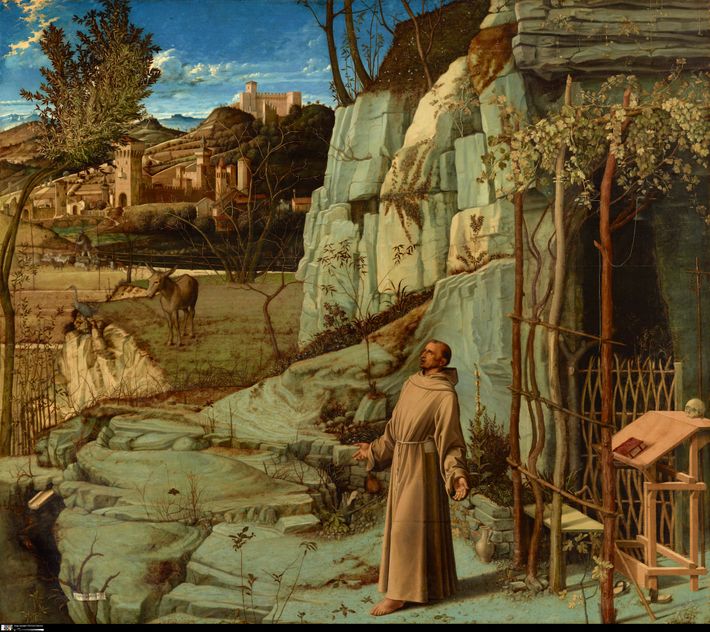Almost everything I know about art I either learned by looking at it and talking to myself, or from listening to artists talk about art. They see all of it through their own work, their own notions. Cave paintings and Courbet exist in the same frame of aesthetic reference. Usually, they donÔÇÖt care about the minutiae of art history, behind-the-scenes stories, biographical information, or critical consensus. (Luc Tuymans recently gave a talk at ViennaÔÇÖs tremendous Kunsthistorisches Museum about paintings in its collection that fail.) An artistÔÇÖs self-informed viewpoint can be at once the narrowest and most limiting but also the most liberated and fecund view of art there is: entirely subjective, sometimes bonkers, beyond right and wrong. If the artist is articulate or witty, he or she can explode work youÔÇÖve seen a hundred times, making you see it in ways youÔÇÖve never thought of ÔÇö which then become yours as well.

I think that magic was worked on me last night at the inimitable Frick Collection. In a clipped one-hour talk staged by Frieze Masters, the highfalutin old-and-modern-masters branch of the Frieze Art Fair ÔÇö which opens on Randalls Island on Thursday ÔÇö I listened to Ed Ruscha speak to the FrickÔÇÖs director, Ian Wardropper, about eight paintings he selected from that amazing museum. RuschaÔÇÖs insights, delivered in his matter-of-fact laconic Oklahoma drawl, dazzled. Wardropper provided the perfect background in every case.
Below are bits of what I remember and madly wrote on scraps of paper found in my pocket. First up, he spoke about one of the clearest and most beautiful pictures in this hemisphere, Giovanni BelliniÔÇÖs St. Francis in the Desert. Ruscha called Francis an ÔÇ£urban farmer,ÔÇØ I think because this desert is rich and blooming and that town is in sight. He kept marveling at ÔÇ£all these diagonals.ÔÇØ Huh? Diagonals? Then the whole picture shifted for me, from being this gorgeous clear thing that IÔÇÖve known all my life to something made up of hundreds of harmonizing angles. He talked about how FrancisÔÇÖs chest was ÔÇ£straining to be at an angleÔÇØ and how the writing table behind him establishes two other diagonals, as do the landscape and the tree leaning into the saint. He talked about ÔÇ£the crazy quilt of little compartmentsÔÇØ in the picture, in the rocks, ground, fields, and town beyond. I think he said the cliff looks like ÔÇ£a monster.ÔÇØ It now looks that way to me. After saying simply ÔÇ£ThereÔÇÖs plenty to look at in this picture,ÔÇØ he said, ÔÇ£It has the makings of any picture. It would look great on its side or upside down.ÔÇØ Suddenly the painting flipped in my mind, and I beheld a new magnificence. As this happened, Ruscha remarked that ÔÇ£you should be able to look at any good painting from several sides.ÔÇØ Now I believe that too. HeÔÇÖd spoken maybe seven minutes, and a world had opened.
Then Hans MemlingÔÇÖs Portrait of a Man: Rucsha talked about the ÔÇ£stark powerÔÇØ of this simple picture and ventured that ÔÇ£It must have aggravated artists because it was so shocking. It looks like someone I might know. Like someone I might pass on the street. The cut of his hair. Like a baseball player.ÔÇØ And with that, this amazing figure turned into a bubblegum card. Before I could ease into that correct revelation Ruscha said ÔÇ£He looks like Jose Canseco.ÔÇØ DÔÇÖoh! Him?! He talked about how the figure is ÔÇ£in our space,ÔÇØ how the artist painted the frame into the picture, and the great way that the blue sky changes colors from top to bottom, singling out the white of the ÔÇ£dagger dart in his collar.ÔÇØ He didnÔÇÖt care who this figure was or what city was in the background (itÔÇÖs Bruges). He said, ÔÇ£I try not to think about the backstory of a painting.ÔÇØ You have to be able to ÔÇ£see a picture cold.ÔÇØ He┬á declared this painting ÔÇ£a winner.ÔÇØ
Since by then IÔÇÖd already run out of paper, here are some more fragments. Hans HolbeinÔÇÖs Sir Thomas More looks ÔÇ£wicked, cruel, ambiguous.ÔÇØ Ruscha talked about how some paintings are like ÔÇ£a 100-piece orchestra,ÔÇØ and I think he said that this one had a bunch of instruments in it. He talked about how a lot of the things in the painting ÔÇ£donÔÇÖt fitÔÇØ or ÔÇ£look very twentieth-century.ÔÇØ

HereÔÇÖs a link to the whole talk, where you can hear what he had to say about Goya, Manet, two great El Grecos, and what he thinks about how the Frick is now displaying his own work with some fabulous bronzes. One other thing: Last night RuschaÔÇÖs was just one of three artists talks all within a few blocks of one another on the Upper East Side. This sort of embarrassment of riches might make us stop for a second, set aside the fourth rule of the art world ÔÇö which is to always complain about the art world, bitterly ÔÇö and simply feel lucky to be here, living a life in art and around artists. Oh, and artists: Look at your work upside-down and sideways. I know I will.

